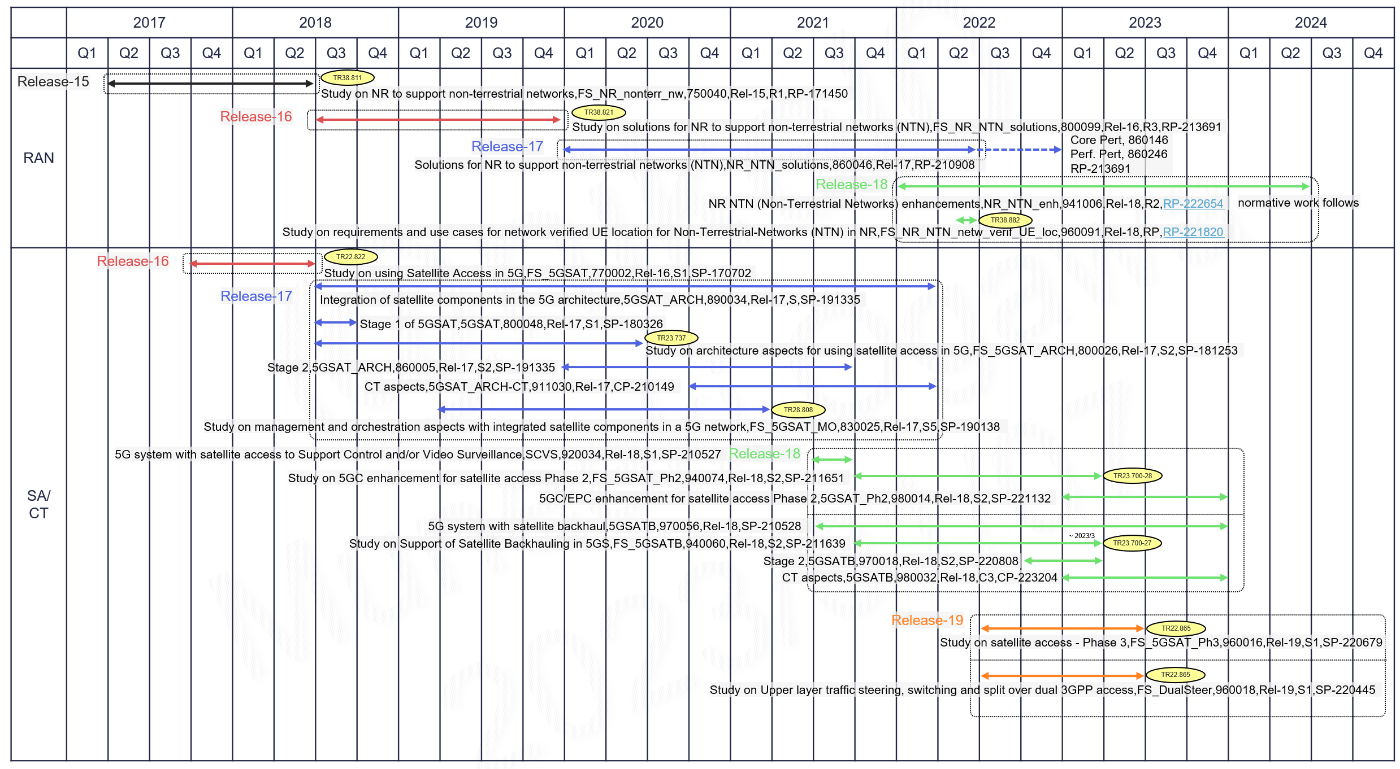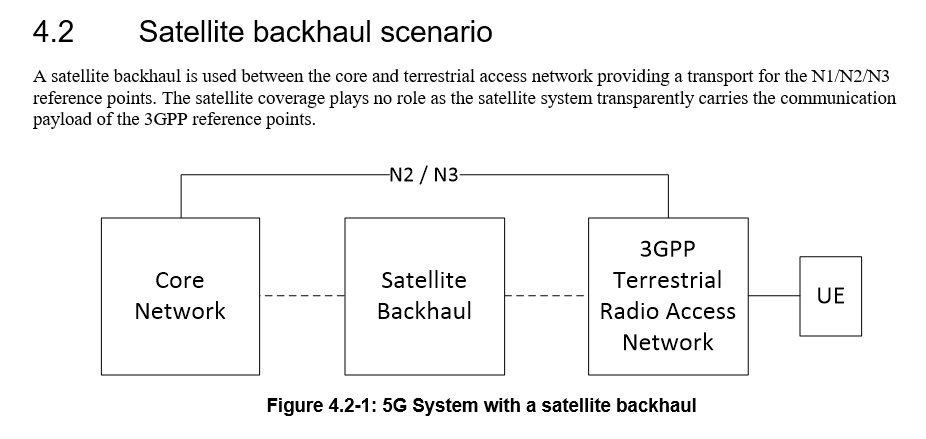3GPP NTN(Non-Terrestrial Network) WI/SI サマリー
3GPPでは5Gの標準化活動の初期のリリースであるRelease-15から地上系ネットワークと衛星ネットワークの統合の重要性について認識され現在も継続して検討、標準化が行われています(下図参照)。
標準化活動は、RAN(無線アクセスネットワーク)、SA(サービスとアーキテクチャ)、CT(コアネットワークと端末)のTSG(技術仕様グループ)にわたり、複数のSI(スタディアイテム)とWI(ワークアイテム)が立ち上げられ、それぞれ研究及び仕様の標準化が行われています。
衛星通信アクセスの5Gシステムへの統合において、衛星通信部分は地上ネットワーク(Terrestrial Network)との対比でNTN(Non-Terrestrial Network)と呼ばれています。
この記事では3GPPにおけるNTNの標準化活動についてRelease-15からRelease-18(検討中のRelease-19を一部含む)までに立ち上げられたSI/WIを列挙すると共に、その内容を簡単に記載しています。

Release-15
RAN
Study on NR to support non-terrestrial networks, FS_NR_nonterr_nw, 750040, Rel-15, 100%, R1, RP-171450→ SP-220679
背景
5GにおけるNTN(Non-Terrestrial Network)の役割と利点は3GPPで紹介、議論されており、SAとRANの両方でユースケースが確認されている。
- the support of “5G connectivity via satellite” within 3GPP TR 23.799
- the “Higher availability” requirement within 3GPP TR 22.862
- the “Wide Area Connectivity” requirement within 3GPP TR 22.863
- the “Satellite Access” requirements within 3GPP TR 22.864
- the “5G Connectivity Using Satellites” use case of 3GPP TR 22.891
- the “Satellite extension to Terrestrial” within 3GPP TR 38.913
これらは、TS 22.261において衛星アクセスをサポートするという要件に取り込まれている。
NTNとは、通信に航空機(Airborne)や宇宙船(Spaceborne)を使用するネットワークまたはネットワークセグメントを指す。
- 宇宙船(Spaceborne):Satellites (including Low Earth Orbiting (LEO) satellites, Medium Earth Orbiting (MEO) satellites, Geostationary Earth Orbiting (GEO) satellites as well as Highly Elliptical Orbiting (HEO) satellites)
- 航空機(Airborne):High Altitude UAS Platforms (HAPs) encompassing Unmanned Aircraft Systems (UAS) including tethered UAS and Lighter than Air UAS (LTA), Heavier than Air UAS (HTA), all operating in altitude typically between 8 and 50 km, quasi-stationary
NTNは以下のような形で5Gサービス利用されることが期待される。
- 地上波ベース5Gネットワークの到達範囲を広げることで、UE(特にIoT/MTC、PS/MC)に対して5Gサービスを提供
- 物理的な攻撃や自然災害に対して空中/宇宙飛行体の脆弱性が低いことによる、5Gサービスの信頼性と回復力の提供
- 航空機に搭載されたUEへ5Gサービスを提供する
- 船舶や列車など、移動するプラットフォームに搭載されたUEへの5Gサービスを提供する
- A/Vコンテンツ、グループ通信、IoTブロードキャストサービス、ソフトウェアダウンロード(コネクテッドカーなど)、緊急メッセージなどのサービスの効率的なマルチキャスト/ブロードキャスト配信
- TNとNTNのネットワーク間で、5Gサービスのトラフィックエンジニアリングを柔軟に行うことが可能
上記のようなメリットを最大化するためには、NTNと5G RATとの間で、高いレイヤーの統合と無線インターフェースの共通化が必要となる。
Rel-15では(当初は)以下の活動を行う予定であったが、時間の制約により活動Aのみを実施した。
- 活動A:NTNチャネルモデルを研究し、デプロイメントシナリオ、パラメータを定義し、NRへの主要な潜在的インパクトを特定する。
- 活動B:活動Aで特定された主要なインパクトに対するソリューションを評価し、RANプロトコル/アーキテクチャへの影響を調査する。
Release-16
RAN
Study on solutions for NR to support non-terrestrial networks (NTN), FS_NR_NTN_solutions, 800099, Rel-16, 100%, R3, RP-190710
背景
Rel-16では活動Bを実施した。
- 活動A:NTNチャネルモデルを研究し、デプロイメントシナリオ、パラメータを定義し、NRへの主要な潜在的インパクトを特定する。
- 活動B:活動Aで特定された主要なインパクトに対するソリューションを評価し、RANプロトコル/アーキテクチャへの影響を調査する。
SA
Study on using Satellite Access in 5G, FS_5GSAT, 770002, Rel-16, 100%, S1, SP-170702
(省略)
Release-17
RAN
Solutions for NR to support non-terrestrial networks (NTN), NR_NTN_solutions, 860046, Rel-17, 0%, , RP-213691
背景
RAN#76以降、NTNをサポートするための2つのFSが実施された。
- FS_NR_nonterr_nw(RP-171450参照):NTNチャネルモデルを研究し、デプロイメントシナリオ、パラメータを定義し、NRへの主要な潜在的インパクトを特定した。RAN#76で開始されRAN#80 で完了。TR 38.811。
- FS_NR_NTN_solutions(RP-190710参照):最初の活動で特定された主要なインパクトに対する解決策を定義し、評価した。RAN3が主導。RAN#80で開始されRAN#86で完了。TR 38.821。
RAN#85 と#86 の間で、NTNに関するREl-17 WIのスコープについて議論された(RP-192500)。
その結果、Rel-17 は以下2つに取り組むことに合意した。
- Normative
- 少なくとも3GPPクラス3 UEに対応する透過型ペイロードLEOシナリオと、FixedまたはMovingセルシナリオ。LEOの問題を解決することはHAPSのサポートも意味する。GNSS能力は問わない。
- UE with GNSSに対する透過型ペイロードGEOシナリオ。
- Study
- 透過型ペイロードHAPSシナリオ。セルラーとのスペクトラム共存のためのの研究(追加コアセット、PCI混乱緩和など)
- IoT-NTNベースのシナリオ
- NTNに基づくUEの位置情報(規制サービス用)
SA
Integration of satellite components in the 5G architecture, 5GSAT_ARCH, 890034, Rel-17, 88%, S, SP-191335
背景
TR 23.737の結論に基づいて以下のNormative作業を行う。
- Mobility Management with large coverage areas.
- Mobility Management with moving coverage areas.
- Delay in satellite.
- QoS with satellite access.
- QoS with satellite backhaul.
- RAN mobility with NGSO regenerative-based satellite access.
- Regulatory services with super-national satellite ground station.
Stage 1 of 5GSAT, 5GSAT, 800048, Rel-17, 100%, S1, SP-180326
背景
TR 22.822のユースケースに基づきStage 1要件を規定する。以下のユースケースに対応する。
- Roaming between terrestrial and satellite networks
- Broadcast and multicast with a satellite overlay
- Internet of Things with a satellite network
- Temporary use of a satellite component
- Optimal routing or steering over a satellite
- Satellite trans-border service continuity
- Global satellite overlay
- Indirect connection through a 5G satellite access network
- 5G Fixed Backhaul between NR and the 5G Core
- 5G Moving Platform Backhaul
- 5G to Premises
- Off-shore Wind Farms
Study on architecture aspects for using satellite access in 5G, FS_5GSAT_ARCH, 800026, Rel-17, 100%, S2, SP-181253
背景
フェーズアプローチをとる。Rel-17ではフェーズ1に取り組む。
- Phase 1 – To Enable the provision of services via satellite access by addressing the main issues raised by two structuring reference use cases, namely
- Roaming between terrestrial and satellite networks – to cover the direct satellite access
- 5G Fixed Backhaul between NR and the 5G Core – to cover the satellite backhaul
- Phase 2 – Enhance the provision of services via satellite access leveraging future 5G features by covering the other use cases defined in TR22.822.
目的
- Network discovery & selection – how to define and add the satellite access network identities?
- User Plane handling and efficiency – Does satellite integration impact the UP processing and UPF selection? How?
- Mobility management – how to design an efficient tracking area when integrating a non-geostationary satellite access? What are the minimal solutions to adapt or create CN based paging procedures, etc.?
- UE localisation – how to manage the UE localisation information with satellite integration?
- Network Slicing with satellite integration in the system taking into account its inherent characteristics.
- QoS framework - When considering the above use cases, should the QoS framework be adapted, and if so how? E.g. Do longer delays have impact on messages at N1/N2/N3 reference points? Does the system need to adjust the QoS depending on whether a satellite is used?
- RAN/CN functional allocations – How do country codes work in the case of cells spanning several countries? When the HPLMN is in one country, the user in a VPLMN in a second country, how to handle a satellite gateway that could be in a third country? More generally, satellite integration might require adjusting the allocations of functions between the RAN and CN.
- Security architecture - What are the regulatory issues and the corresponding solutions for the integration of satellite in a 5G system, in particular given the footprint of a satellite network (or the global access area with Inter-Satellite Links and On Board Processing)?
Study on management and orchestration aspects with integrated satellite components in a 5G network, FS_5GSAT_MO, 830025, Rel-17, 100%, S5, SP-190138
目的
衛星コンポーネント(NG-RANまたは非3GPPアクセスとして、または輸送用として)を統合した5Gネットワークのビジネスロール、サービスおよびネットワーク管理、オーケストレーションに関連する主要な問題を特定し、関連ソリューションを研究する。
この研究は、既存の5Gネットワークのビジネスモデル、管理、オーケストレーションにおける衛星統合の影響と複雑さを最小限にすることを目的とする。
CT
CT aspects of 5GC architecture for satellite networks, 5GSAT_ARCH-CT, 911030, Rel-17, 76%, , CP-210149
目的
-
Study phase
a) Determination of the country of the UE location for the purpose of PLMN selection for satellite networks
b) Lawful Intercept (LI) requirements for satellite networks
c) New RAT type(s) for satellite networks
d) Cells broadcasting multiple MCCs
e) Rules for PLMN search
f) Equivalent PLMN
g) Networks using global MCC(s) -
Normative phase
-
CT1
- ステージ2要件のサポート
- PLMN選択の要件と解決策のサポート
-
CT3/CT4
- ステージ2要件のサポート
-
CT6
- USIMのステージ2要件のサポート
Release-18
RAN
NR NTN (Non-Terrestrial Networks) enhancements, NR_NTN_enh, 941006, Rel-18, 0%, R2, RP-213690
背景
- Rel-17
- Transparent payload based GSO and NGSO network scenarios addressing at least 3GPP power class 3 UE with GNSS capability in both Earth fixed and/or moving cell configurations
- Rel-18
- frequency bands above 10 GHz
- Offer optimized performance especially when addressing handset terminals
- Provide mobility and service continuity enhancements considering the NTN characteristics such as large propagation delay and satellite movement
- regulatory requirements (e.g., Lawful intercept, emergency call, Public Warning System, …) 関連
目的
以下を前提としたHAPSとATG(Air To Ground)のサポート
- GSO and NGSO (LEO and MEO) with transparent payload.
- Earth fixed tracking area. Earth fixed & Earth moving cells for NGSO
- FDD mode
- UEs with GNSS capabilities
- Both “VSAT” devices with directive antenna (including fixed and moving platform mounted devices and commercial handset terminals (e.g. Power class 3) are supported in FR1
- Only “VSAT” devices with directive antenna (including fixed and moving platform mounted devices) are supported in above 10 GHz bands.
詳細は以下
- Coverage enhancement
- スマホでのVoIP and low-data rateのサポートのために、現在のNTN回線設計では0dBiを想定しているが、より現実的な仮定を置く
- NR-NTN deployment in above 10 GHz bands
- GSO and NGSO (e.g. LEO, MEO, HEO) based satellite accessがスコープ
- ESIM scenarios for NGSO in Ka bandはスコープ外
- fixed and mobile VSATがターゲット
- FDD modeが前提
- NTN-TNでのバンドの重複はスコープ外
- 2026年6月以降に検討
- Network verified UE location
- NTN-TN and NTN-NTN mobility and service continuity enhancements-
SA
5G system with satellite access to Support Control and/or Video Surveillance, SCVS, 920034, Rel-18, 100%, S1, SP-210527
(略)
Study on 5GC enhancement for satellite access Phase 2, FS_5GSAT_Ph2, 940074, Rel-18, 0%, S2, SP-211651
前提知識
Release-17のSIであるFS_5GSATでは、5Gにおける衛星アクセスのサービス要件に対応するため各種検討を行い結果をTR 23.737にまとめている。下の図はTR 23.737で提起されたKey issuesとそれに対するSolutionsの対応を示している。背景が白のKey issuesはsolutionが提示されなかったもの、また背景が白のSolutionsは提示されたものの、比較検討により採用されなかったものを示している。

背景
Release-17の5GSAT_ARCHでは、NGSO再生(regenerative-based)ベースの衛星アクセスが検討されていない。
Key Issue #6(RAN mobility with NGSO regenerative-based satellite access)とその解決策はTR 23.737で示されたが、RANがこの機能をサポートしていないため、Release-17では解決策が規定できなかった。
Release-18での優先順位付けの後、NGSO再生ベース衛星アクセスの5GCアーキテクチャへの影響に関する検討を行う予定となっている。
RAN WGでは、5GCに影響を与える機能として、不連続カバレッジ(Discontinuous coverage)も提案されている。不連続カバレッジの動的なサポートは、最初のNGSOコンステレーション展開に必要であり、衛星故障、コンステレーションのマイグレーションに対応するためにも必要となる。UE は、コンスタレーションがまばらであるため、特定の時間や場所でのみ衛星サービスのカバレッジに アクセスすることとなる。UEは、効率的なページングのためネットワークがUEの位置を認識できない時間が発生する。このため、モビリティ管理を強化する必要がある。また、特にMIoT UEでは、電力効率の観点からUEが常時起動している必要はないかもしれない。そのため、UEが一時的に圏外になった場合の予測、UEウェイクアップ時間の認識・通知、データの保存・転送に関するメカニズムが必要となる可能性がある。また、動的なビーム構成の使用によりビーム/セルが断続的になる動的なGEOシステムに関連する不連続なカバレッジも重要な側面となる。この問題は、ブロードキャスト/マルチキャストの場合にも適用される。
Release-18 の検討のための優先順位付けプロセスの後、ブロードキャスト/マルチキャストの不連続カバレッジをサポートするためのアーキテクチャの強化はこのSIDから除外され、RANの要求があればRelease-18中に再び検討される可能性がある。
目的
本SIでは、衛星アクセス時の5GC/EPCの拡張をさらに検討する。
- モビリティ強化(例:ページング強化)のための不連続カバレッジのサポート
- UEウェイクアップ時間の予測・認識・通知の検討
- 省電力最適化
5GC/EPC enhancement for satellite access Phase 2, 5GSAT_Ph2, 980014, Rel-18, 0%, S2, SP-221132
Work Item
Study on Support of Satellite Backhauling in 5GS, FS_5GSATB, 940060, Rel-18, 0%, S2, SP-211639
前提知識
Release-17 TR 23.737では衛星アクセスにおける5GSでのアーキテクチャの側面の検討がなされた。
衛星アクセスを利用する2つのシナリオとして、以下が記載されている。

normative workにおいては、5GSにおける衛星バックホールをサポートするための機能拡張として以下が規定されている。
- ネットワーク・コンフィギュレーションに基づく衛星バックホール・カテゴリの検出
- バックホール変更時のPCFへのイベント報告
- サテライトバックホールのカテゴリに基づくポリシー決定
- サテライトバックホールカテゴリの変更に関するAFへの通知
背景
衛星はモバイルブロードバンドアクセスの広範なカバレッジを提供できる。通信キャリアは、フリンジ領域(例:遠隔ルーラルエリア)、緊急または一時的な措置(例:災害地域、免許承認待ちの間のマイクロ波リンクの代わり)の場合に、衛星をgNB用のバックホールサービスを提供するために使用できる。
Release-17では、5GSのための衛星バックホール接続が検討されてた。この検討は主に、CPとUPのバックホール接続に1つの衛星(GEOまたはNGSO衛星)だけが関与する基本的なケースに焦点を当てていた。
5GSでサテライトバックホール接続を使用する以下のケースは、Release-17では検討されなかった。
- gNBが衛星を経由して5GCとISL(Inter Satellite Link)接続する場合
- ハイブリッドバックホール(例:衛星と地上のバックホール、または異なるタイプの衛星バックホール)を使用して5GCに接続するgNB
バックホール接続にISLが含まれる場合、衛星バックホールカテゴリは、ネットワーク構成に基づいてのみ決定することができず(例えば、LEOとGEO間のISLが含まれる場合)、PCFとAFは既存のQoS要件を満たすことができるかどうか判断できなくなる。
衛星リンクはパケット配信の遅延が大きく、帯域幅に制限があるため、衛星バックホールがUEに使用される場合、EC(エッジコンピューティング)サービスの提供や衛星でのローカルスイッチングを可能にするなど、バックホール接続を短縮することが有益と考えられる。
衛星上でECまたはローカル・スイッチングをサポートするという現在のアーキテクチャ要件によると、UPFを衛星上に展開する必要があり、5GSを拡張して衛星上でUPFをサポートする必要がある。さらに、ECサービス(IoTアプリケーションのコンピューティングサービスなど)を提供するためには、衛星上にECサーバを配備する必要もある。
目的
本SIでは以下のトピックを調査することを目的とする。
- 衛星バックホールのみを有するgNBの場合、遅延の変化や帯域制限のあるバックホールへの対応のためのアーキテクチャ拡張(UPパス上の衛星バックホールのパケット到達遅延や帯域の検出に基づくポリシー/QoS制御の拡張、バックホール情報のAFへの公開などを含む)
- 地上にgNBを配置し、GEO衛星に展開されたUPFをサポートするためのアーキテクチャの強化(データ伝送の待ち時間を短縮し、バックホール資源の消費を最小限に抑えるために、搭載されたUPFを介して衛星エッジコンピューティングサービスを有効にするかどうか、またその方法、通信中のUEが搭載されたUPFによってサービスを受ける場合のローカルスイッチを強化する方法などを含む)
以下、2023/01/07更新
5G system with satellite backhaul, 5GSATB, 970056, Rel-18, SP-210528
Work Item(1st level)
Stage 2 of 5GSATB, 5GSATB, 970018, Rel-18, S2, SP-220808
Work Item(2nd level)
CT aspects of 5GSATB, 5GSATB, 980032, Rel-18, C3, CP-223204
Work Item(2nd level)
Release-19
SA
Study on satellite access - Phase 3, FS_5GSAT_Ph3, Rel-19, S1, S1-220193 → SP-220679
以下、2023/01/07更新
- Store and forward operation with discontinuous feeder link for delay-tolerant IoT
- UEにサービスを提供する衛星が直接利用できるフィーダーリンクがない場合でも、不連続フィーダーリンクでの保存と転送の動作のサポートにより、NGSOコンステレーションを介してDelay tolerant IoTをサポートする
- GNSS independent operation
- GNSSフリーオペレーションをサポートすることで、GNSS受信機を持たないUEや、IoTやMBBデバイスのGNSSサービスにアクセスできないUEに衛星アクセスを提供することが可能になる
- Positioning Enhancements for satellite access
- TNにおける既存の測位要件とNTNアクセスで満たすことのできる要件とのギャップを見つけ適切なKPIを決定する。新しいユースケース(positioning assistanceを含む)と新しいKPI(測位精度、信頼性、レイテンシなど)を検討
-
Traffic scheduling between multiple-RAT (terrestrial and satellite access network/multi orbit)-
複数軌道の衛星アクセス(例:GEO、MEO、LEO、HEO)とTN-RATによる複数RAT間のトラフィックスケジューリングの検討。この目的は、ATSSSのステアリング要件や機能性をカバーすることを意図していない。(QのSIで検討)→ FS_DualSteerへ移管された
-
-
Local Data Switching (e.g. via CN) on satellite for UEs in a communicationCommunication between UEs under the same satellite’s coverage→名称変更- 5G-LAN Serviceを使ったグループコミュニケーション
-
Connectivity of Temporary local CN using satellite networkIsolated Operation for Public Safety feature (IOPS) に関するギャップ分析
-
Prioritisation of satellite based transport network resources for high priority users→削除された-
サービス要件を満たすための5Gシステムと衛星ベースのトランスポートネットワーク間の協力(Cooperation) e.g. dynamical space network topology、ISL伝送の不確実性など、衛星通信の特殊性を考慮したデータ伝送のQoS要件など→削除された
-
Study on Upper layer traffic steering, switching and split over dual 3GPP access, FS_DualSteer, 960018, Rel-19, S1, SP-220445
以下、2023/01/07追記
Study additional use cases and potential service requirements that could benefit from 5GS support of upper layer steering, split and switching of UE’s traffic (e.g. pertaining to the same data session) across two 3GPP access links, assuming only single subscription to a PLMN, including the following scenarios:
- Single PLMN, PLMN plus (standalone) NPN, two PLMNs
- Same or different 3GPP RATs (NR or NTN, plus one of NR, NTN or LTE)
Note: NTN refers to NR-based satellite access, including different orbits (e.g., GEO/MEO/LEO).
For the PLMN plus PLMN/NPN scenarios, the two networks can be managed by the same operator or by different operators (assumed to have a business agreement among them).
The study includes a gap analysis with regard to the support of the identified use cases by existing service requirements and functionalities, including the potential applicability of existing multi-NW requirements (e.g. from TS 22.261 sec. 6.1, 6.3, 6.18, 6.41).
NOTE 1: simultaneous connectivity over dual 3GPP access assumes UE support of proper radio capabilities (e.g., dual radio).
NOTE 2: it is assumed that there are no impacts to normal inter-PLMN roaming scenarios.
Discussion